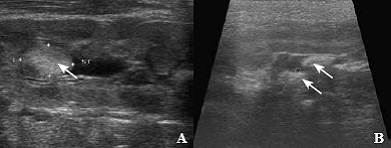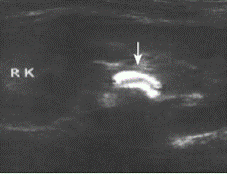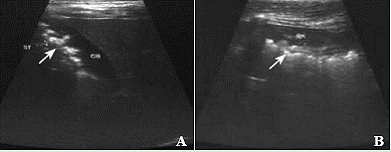|
Ultrasonographic characteristics of
urolithiasis in children exposed to melamine-
tainted powdered formula
Yu He, Guo-Ping Jiang, Lei Zhao, Jing-Jing Qian, Xiu-Zhen Yang, Xiao-Ying Li,
Li-Zhong Du, Qiang Shu
Hangzhou, China
Author Affiliations: Department of Ultrasound, Children's Hospital, Zhejiang University School of Medicine and Zhejiang Key Laboratory for Diagnosis and Therapy of Neonatal Diseases, Hangzhou 310003, China (He Y, Jiang GP, Zhao L, Qian JJ, Yang XZ, Li XY, Du LZ, Shu Q)
Corresponding Author: Guo-Ping Jiang, MD, Children's Hospital, Zhejiang University School of Medicine, Hangzhou 310003, China (Email: jgp_hz@yahoo.com.cn)
doi:10.1007/s12519-009-0023-4
Background: Since the outbreak of renal diseases among children who had consumed melamine-tainted powdered formula in 2008, urinary system ultrasound examination was carried out for these children at our hospital. This study aimed to investigate the ultrasonographic characteristics of urolithiasis caused by melamine-tainted powdered formula.
Methods: From September 12 to October 9, 2008, urinary system ultrasound examination for children after consumption of melamine-tainted powdered formula was carried out at the Children's Hospital of Zhejiang University, China. A total of 15 577 infants and children were subjected to the examination. A questionnaire with items including demographic characteristics, history of exposure and clinical symptoms were completed before examination.
Results: Among the 15 577 children, 7988 were boys and 7589 girls with age ranging from 1 month to 15 years (mean age, 22 months). Urolithiasis was found in 562 patients with an identification rate of 3.6%. Urolithiasis was identified mainly in the children aged 36 months or younger (88.6%). Unilateral kidney calculi were found in 431 children and bilateral kidney calculi in 131 children. Eleven of these children also had ureteric calculi, 1 had bladder calculi, 2 had urethral calculi, and 2 had gallbladder calculi. Fifteen children had urinary tract obstruction. Ultrasonographic characteristics of these melamine calculi were different from the calcium oxalate calculi, i.e., the lesions were less echogenic, had a more "sandy" appearance and were less dense. The posterior portion of the calculi could be observed and was accompanied with a feeble or absent acoustic shadow.
Conclusions: Melamine-induced calculi were ultra-sonographically less echogenic, sand-like and discrete; the posterior portion of the calculi was accompanied with a feeble or absent acoustic shadow. It might be a new type of urolithiasis in children.
Key words: formula; infants; melamine; ultrasonography; urolithiasis
World J Pediatr 2009;5(2):118-121
Introduction
In September, 2008, the children in Gansu Province in China had been hospitalized with urolithiasis, evidently after having consumed melamine-tainted powdered formula. Melamine is an industrial chemical used primarily as a plastic stabilizer and fire retardant. Free screening programs were then launched nationwide in the mainland China. Since September 12, our hospital initiated this screening program. Rare reports have been published on ultrosonographic characteristics of melamine induced urolithiasis in human before this epidemic. We aimed to describe the ultrosonographic characteristics of melamine induced urolithiasis in the present report.
Methods
From September 12 through October 9, 2008, a total of 15 577 children, who had been exposed to melamine-tainted powdered formula, were subjected to ultrasonographic examination at Children's Hospital, Zhejiang University School of Medicine. Before ultrasonography, a questionnaire with items including demographic characteristics (sex, age and so on), the history of exposure (brand of formula, content of melamine, duration of exposure, feeding type), and symptoms (fever, unexplained crying during urination, etc) of the children were completed.[1]
The content of melamine was estimated according to the report by the General Administration of Quality Supervision, Inspection, and Quarantine of the People's Republic of China. Twenty-two brands of infant formula were reported to be contaminated, with reported concentrations of melamine ranging from 0.09 to 2563 ppm).[2] Children who had been fed with baby formula for at least 30 days were considered to have been exposed.[3]
The ultrasound instruments were HDI5000, HD-7, HD3 from Philips, Logiq5 and LogiqP5 from GE, G60 from Siemens, and Toshiba SSD-390A. The frequency of high-frequency probe was 6-12 MHz and that of convex array probe was 3.5 MHz. High frequency probes were used to scan from left to right and from the anterior to the posterior parts on long axis view of the kidneys, and from the upper to the lower parts on short axis view of the kidneys. Renal parenchyma, renal pelvis, renal calyces, ureter, bladder, and urethra were sequentially examined. If urinary calculi were found, the biliary tract was examined. The type, location, echogenicity, and size of the calculi, as well as the acoustic shadow were analyzed.
Results
Among the 15 577 children, 7988 were boys and 7589 girls with an age range of 1 month to 15 years (mean age, 22 months). On ultrasonography, urolithiasis was found in 562 children with an identification rate of 3.6%.
Identification rate of urolithiasis in different age groups
The identification rate of urolithiasis varied in age groups. Infants aged 6 months to 12 months showed the highest identification rate of 6.21%. Urolithiasis was identified mainly in the children aged 36 months or younger. A total of 498 children in this age group were detected to have urolithiasis, accounting for 88.6% of the total urolithiasis cases identified (Table 1).
Location of calculi
Calculi in a single kidney were found in 431 children, of whom 7 children also had ureteric calculi, 1 had bladder calculi, 1 had urethral calculi, and 1 had gallbladder calculi. Calculi in both kidneys were found in 131 children, of whom 4 were combined with bilateral ureteric calculi, 1 with urethral calculi, and 1 with gallbladder calculi. Fifteen children had evidence of urinary tract obstruction.
In all, 3 children were found to have biliary calculi. Among them, 2 were combined with urolithiasis shown as above, and the other one was found to have calculi in the intrahepatic bile duct without urolithiasis. Records from the questionnaire showed that all the 3 children had been fed with a single brand of powdered formula alone for more than 6 months before examination. This brand of powdered formula was reported to be tainted with a high concentration of melamine (Sanlu powdered Formula, 2563 ppm[2]).
Ultrasonographic characteristics of the calculi
Nineteen children had large calculi (¡İ10 mm in diameter) which were detected in the renal pelvis and ureter, 108 had medium sized calculi (4-9 mm in diameter), 371 had small calculi (<4 mm in diameter) and 64 had sand-like calculi. Ultrasonographic characteristics of these melamine calculi were different from those of calcium oxalate calculi: the lesions were less echogenic, had more "sandy" appearance, were structurally less dense and associated with a feeble (Fig. 1) or absent acoustic shadow (Fig. 2). The posterior portion of the calculi could be observed (Fig. 2).
Ultrasonographically, 3 of the 562 urinary tract calculi exhibited unusual image with enhanced echo at the anterior and posterior margins of the calculi, but with decreased echogenicity in the center in several planes (Fig. 3).
In the 3 cases with biliary calculi, the echogenecity and characteristics of biliary calculi were similar to those of urolithiasis caused by melamine (Fig. 4).
Table 1. Identification rate of urolithiasis in different age groups
|
Age
(mon) |
Tested children
|
Children identified
with urolithiasis |
Identification rate
(%) |
|
<6
|
1057
|
49
|
4.64
|
|
-12
|
2496
|
155
|
6.21
|
|
-18
|
2311
|
74
|
3.20
|
|
-24
|
2437
|
117
|
4.80
|
|
-30
|
1825
|
37
|
2.03
|
|
-36
|
1925
|
66
|
3.43
|
|
-42
|
1022
|
11
|
1.08
|
|
-48
|
822
|
24
|
2.92
|
|
-54
|
502
|
5
|
1.00
|
|
-60
|
387
|
10
|
2.58
|
|
-66
|
196
|
3
|
1.53
|
|
-72
|
175
|
5
|
2.86
|
|
-78
|
84
|
1
|
1.19
|
|
-84
|
77
|
1
|
1.30
|
|
>84
|
261
|
4
|
1.53
|
|
Total
|
15 577
|
562
|
3.61
|
Table 2. The main characteristics of urolithiasis induced by melamine compared with the calcium oxalate calculi
|
Ultrasonic
charateristics |
Calcium oxalate
calculi |
Melamine-induced
calculi |
|
Type
|
Entire
|
Small "sandy" calculi
|
|
Density
|
Dense
|
Discrete
|
|
Echogenicity |
Hyperechoic |
Hyperechoic but weaker than calcium oxalate calculi |
|
Echo of the posterior
calculi |
Absent |
Present |
|
Acoustic shadow
|
Present
|
Feeble or absent
|

Fig. 1. Ultrasonographic characteristics of melamine-induced urolithiasis. A 2-year-old boy's ultrasonograph showing an hyperechoic area (4 mm in diameter) (arrow) in the left renal pelvis with a feeble acoustic shadow. The calculi are more discrete and the echo is weaker than the common calcium oxalate calculi.

Fig. 2. Ultrasonograph showing urolithiasis induced by melamine. A: an hyperechoic area (8 mm in diameter) (arrow) is seen in the left renal pelvis in a 2-month-old male infant. B: two hyperechoic areas (4 mm in diameter, both) (arrow) are observed in the left renal pelvis in a 10-month-old male infant. The posterior portion of the kidney calculi can be observed and no acoustic shadow on ultrasonography.

Fig. 3. A 3-year-old girl's ultrasonograph showing urolithiasis induced by melamine. A calculus with a diameter of 11.6 mm in the right renal pelvis showing a special image. Enhanced echo is seen in the anterior and posterior portions of urinary tract calculi, while weaker echo is seen in the middle area of the caculi, which appear to be sandwich-like.

Fig. 4. A 4-year-old girl's ultrasonograph showing urolithiasis and gallbladder calculi. A: Sand-like calculi in the gallbladder with a feeble acoustic shadow. B: Sand-like calculi in the right renal pelvis with a feeble acoustic shadow.
Discussion
Animal experiments and reports relating to the pet food incidents in North America have shown that intake of food containing melamine leads to urinary crystals and injuries.[4-7] Distal tubular lesions were present in animals fed with melamine-tainted pet foods, and unique polarizable crystals with striations were present in distal tubules or collecting ducts in all animals.[8-11] The main components of the calculi were melamine and uric acid as identified in animal experiments.[12] However, there are few reports in the literature describing the ultrasonographic characteristics of melamine-related urolithiasis in humans.
The present study showed that ultrasonographic characteristics of urolithiasis are comparatively less dense, more sand-like and microliths. The calculi were less echogenic than typical calcium oxalate calculi. The posterior portions of most urinary tract calculi can be seen with weak or absent acoustic shadow. It might be a new calculus type caused by the combination of melamine and uric acid (Table 2).
Special ultrasonographic images of calculi were found in three cases. Ultrasonography showed enhanced echo in several profiles of margo anterior and margo posterior of the urinary tract calculi, while the echo was weaker in the middle area of the calculi. According to the theory of ultrasonography, the echo of uric acid is relatively low and the entire calculus can be seen. The echo of melamine might be lower so that a weaker echo is shown in the middle of calculi, indicating that might be the melamine center surrounded by uric acid in this type of calculus. Lam et al[13] suggested that melamine may possibly form the central nidus of the stone, and the other metabolic risk factors propagate the stone-forming process.
Involvement of the liver or other non-renal organs has not been previously reported in humans exposed to melamine. In our study, 3 cases of calculi in biliary tract system were detected. Two of them were complicated by urolithiasis. The ultrasonographic characteristics of biliary calculi were similar to those of urolithiasis. Though the data showed that all 3 cases were fed with the brand of formula tainted with the highest level melamine for more than 6 months, the relation between the length of time of exposure to melamine-contaminated milk products and biliary calculi needs to be further investigated.
Our study has certain limitations. The identification rate of urolithiasis in our hospital was far higher than that in Taiwan[14] and Hong Kong, China.[15,16] Lam et al[15] reported that only one child was confirmed to have renal calculi, 7 were suspected of having melamine related renal deposits among 3170 children exposed to a low dose of melamine. But in our series, a total of 562 children were identified to have urolithiasis with an identification rate of 3.61%. Hong Kong's screening was based at primary care level as first level screening, but our hospital is the largest referral children's hospital in Zhejiang Province, East China. It covers approximately 70% population in Zhejiang province (with a population of 50 million, about 8.45 million children). This investigation was not based on a primary level screening program. Many outpatients at this hospital were suspicious patients with urolithiasis who had been screened at local hospitals. Another reason is that Hangzhou as a provincial capital with a large floating population, has many migrant workers from the nearby provinces such as Jiangxi and Anhui with a lower social economic status. Their children may be exposed to a high dose of melamine while consuming low-cost brands of powdered formula. These products may contain as much as 2563 mg/kg of melamine, whereas the most severely contaminated milk product manufactured in the mainland but commercially available in Hong Kong contained 68 mg/kg.[15] Despite of these limitations, this is one of the largest cohorts published compared against the cohort reported by Guan et al.[1]
In conclusion, melamine-induced calculi were ultrasonographically less echogenic, sand-like and less dense; the posterior portion of the calculi was accompanied with a feeble or absent acoustic shadow. This study describes in detail the ultrasonographic characteristics of melamine-induced renal stones in a largest study cohort, and thus may be helpful to others in detecting melamine-related stones.
Funding: This study was partly supported by grants from Health Bureau of Zhejiang Province (No. 2008ZX006 and No. 2008ZX007).
Ethical approval: This study was approved by the Ethical Committee of Zhejiang Universtiy.
Competing interest: None.
Contributors: Jiang GP wrote this manuscript. All authors approved the final version of the paper.
References
1 Guan N, Fan Q, Ding J, Zhao Y, Lu J, Ai Y, et al. Melamine-contaminated powdered formula and urolithiasis in young children. N Engl J Med 2009 Feb 4. [Epub ahead of print]
2 12320 China Public Health Hot-line. http://www.12320.gov.cn/weisheng_zhuanti/weisheng_sanlu.jsp#_Toc209522633 (accessed February 18, 2009)
3 Zhang L, Wu LL, Wang YP, Liu AM, Zou CZ, Zhao ZY. Melamine-contaminated milk products induced urinary tract calculi in children. World J Pediatr 2009;5:31-35.
4 Cianciolo RE, Bischoff K, Ebel JG, Van Winkle TJ, Goldstein RE, Serfilippi LM. Clinicopathologic, histologic, and toxicologic findings in 70 cats in advertently exposed to pet food contaminated with melamine and cyanuric acid. J Am Vet Med Assoc 2008;233:729-737.
5 Reimschuessel R, Gieseker CM, Miller RA, Ward J, Boehmer J, Rummel, et al. Evaluation of the renal effects of experimental feeding of melamine and cyanuric acid to fish and pigs. Am J Vet Res 2008;69:1217-1228.
6 Dobson RL, Motlagh S, Quijano M, Cambron RT, Baker TR, Pullen AM, et al. Identification and characterization of toxicity of contaminants in pet food leading to an outbreak of renal toxicity in cats and dogs. Toxicol Sci 2008;106:251-262.
7 Yang VL, Batlle D. Acute renal failure from adulteration of milk with melamine. ScientificWorldJournal 2008;8:974-975.
8 Thompson ME, Lewin-smith MR, Kalasinsky VF, Pizzolato KM, Fleetwood MI, Mcelhaney MR, et al. Characterization of melamine-containing and calcium oxalate crystals in three dogs with suspected pet food-induced nephrotoxicosis. Vet Pathol 2008;45:417-426.
9 Puschner B, Poppenga RH, Louenstine LJ, Filigenzi MS, Pesavento PA. Assessment of melamine and cyanuric acid toxicity in cats. J Vet Diagn Invest 2007;19:616-624.
10 Buur JL, Baynes RE, Riviere JE. Estimating meat withdrawal times in pigs exposed to melamine contaminated feed using a physiologically based pharmacokinetic model. Regul Toxicol Pharmacol 2008;51:324-331.
11 Brown CA, Jeong KS, Poppenga RH, Puschner B, Miller DM, Ellis AE, et al. Outbreaks of renal failure associated with melamine and cyanuric acid in dogs and cats in 2004 and 2007. J Vet Diagn Invest 2007;19:525-531.
12 Ogasawara H, Imaida K, Ishiwata H, Toyoda K, Kawanishi T, Uneyama C, et al. Urinary bladder carcinogenesis induced by melamine in F334 male rats: correlation between carcinogenicity and urolith formation. Carcinogenesis 1995;16:2773-2777.
13 Lam CW, Lan L, Che X, Tam S, Wong SS, Chen Y, et al. Diagnosis and spectrum of melamine-related renal disease: plausible mechanism of stone formation in humans. Clin Chim Acta 2009;402:150-155.
14 Wang IJ, Chen PC, Hwang KC. Melamine and nephrolithiasis in children in Taiwan. N Engl J Med 2009 Feb 4. [Epub ahead of print]
15 Lam HS, Ng PC, Chu WC, Wong W, Chan DF, Ho SS, et al. Renal screening in children after exposure to low dose melamine in Hong Kong: cross sectional study. BMJ 2008;337:a2991.
16 Ho SS, Chu WC, Wong KT, Li CK, Wong W, Ng PC, et al. Ultrasonographic evaluation of melamine-exposed children in Hong Kong. N Engl J Med 2009 Feb 4. [Epub ahead of print]
Received December 9, 2008 Accepted after revision April 8, 2009
|

